An automobile is a vehicle designed to transport people and goods. It is typically powered by an engine and runs on roads. Today, automobiles are a crucial part of daily life, offering convenience, comfort, and efficiency.
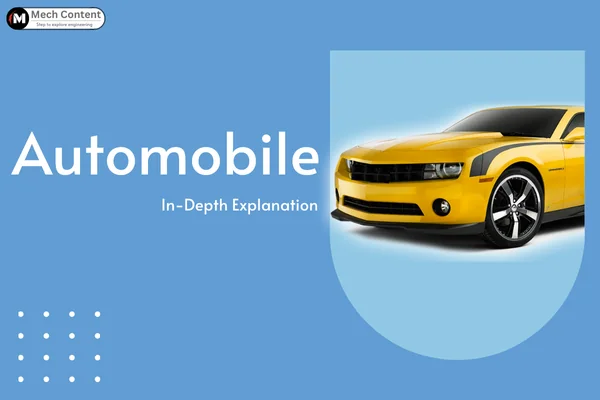
The automobile has changed a lot since it was first invented. In 1885, Karl Benz invented the first gasoline-powered car, which marked the beginning of constant innovation. From steam-powered vehicles to today’s electric cars, the history of the automobile is full of important changes that have shaped how we live and travel.
In this article, we’ll explore key moments in the history of automobiles, their classifications and important systems, and discuss how they work in simple terms. This will help you better understand the journey of the automobile and its role in modern life.
In this article, we’re going to discuss:
- History of Automobile:
- Classification of Automobile:
- Key Parts and Systems in an Automobile:
- How Automobiles Work: An Overview of Key Systems
- Wrapping Up:
History of Automobile:
Invention of the First Car in the World:
The first car in the world was invented in 1885 by Karl Benz, a German engineer and inventor. His vehicle, the Benz Patent Motorwagen, was powered by a single-cylinder, four-stroke engine that ran on gasoline. This automobile could go up to 10 miles per hour and was known for its lightweight design and steering system.
First Commercial Automobile in the World: In 1888, Bertha Benz, Karl Benz’s wife, took a long trip in the Benz Patent Motorwagen to show its potential, helping promote the car.
This led to the first commercial car production by Benz & Cie. The car used a gasoline-powered engine, a key step in automobile history.
Evolution of the Automobile:
Here’s a brief look at how automobiles have evolved over time, shaped by innovation and changing needs.
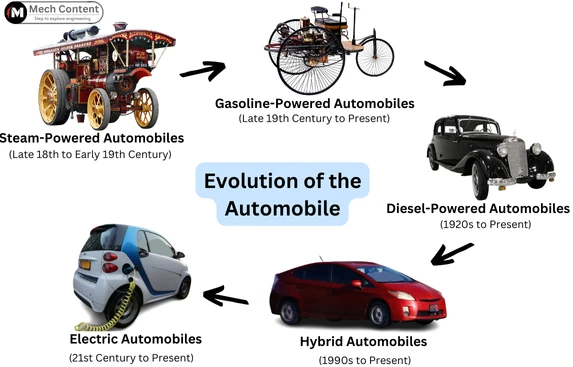
1] Steam-Powered Automobiles (Era Active: Late 18th to Early 19th Century)
Before steam engines, people used horse-drawn carriages for transportation. In 1769, French inventor Nicolas-Joseph Cugnot built the first steam-powered car, a heavy three-wheeled vehicle for carrying goods. Steam cars were popular in the early 1800s but had issues with speed and efficiency.
Contributions and Milestones:
- Nicolas-Joseph Cugnot: 1769: Built the first steam-powered vehicle.
- Richard Trevithick: 1801: Created a road locomotive powered by high-pressure steam.
2] Gasoline-Powered Automobiles (Era Active: Late 19th Century to Present)
The demand for faster, lighter, and more efficient vehicles led to gasoline-powered engine cars. In 1885, Karl Benz invented the first gasoline-powered car, paving the way for modern car manufacturing. Despite their efficiency, early models were limited in speed and reliability.
Contributions and Milestones
- Karl Benz: 1885: Introduced the first gasoline-powered vehicle.
- Gottlieb Daimler: 1886: Developed a high-speed engine suitable for cars.
3] Diesel-Powered Automobiles (Era Active: 1920s to Present)
Diesel engines emerged as a more fuel-efficient alternative, especially in heavy-duty vehicles. Rudolf Diesel invented the diesel engine in 1893, which became popular in the 1920s. Even though they are fuel-efficient, diesel engines were less popular because of emissions and noise.
Contributions and Milestones
- Rudolf Diesel: 1893: Developed the first diesel engine.
- Citroën Rosalie: 1933: First commercial diesel car.
4] Hybrid Vehicles (Era Active: 1990s to Present)
Hybrid technology emerged to reduce fuel consumption and emissions, combining gasoline and electric power. The first commercially successful hybrid car, the Toyota Prius, was launched in 1997, marking a shift toward eco-friendly vehicles.
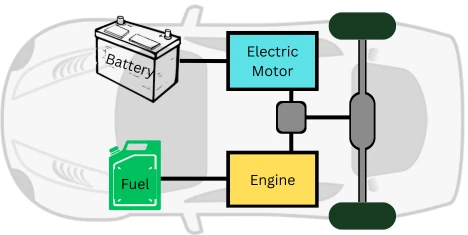
Contributions and Milestones
- Toyota: 1997: Launched the first mass-market hybrid, Prius.
5] Electric Vehicles (Era Active: 21st Century to Present)
Electric vehicles (EVs) gained popularity due to the push for clean energy. Early EVs date back to the late 19th century, but modern advancements, particularly by Tesla, have made EVs more viable. Despite their sustainability, EVs face limitations in battery technology and charging infrastructure.
Contributions and Milestones
- Thomas Davenport: 1834: Developed the first electric motor.
- Tesla: 2008: Launched the Roadster, popularizing modern electric cars.
Classification of Automobile:
Automobiles come in various types, each designed for specific needs and functionalities. These vehicles can be classified based on various factors, such as transmission systems, number of wheels, fuel type, and more.
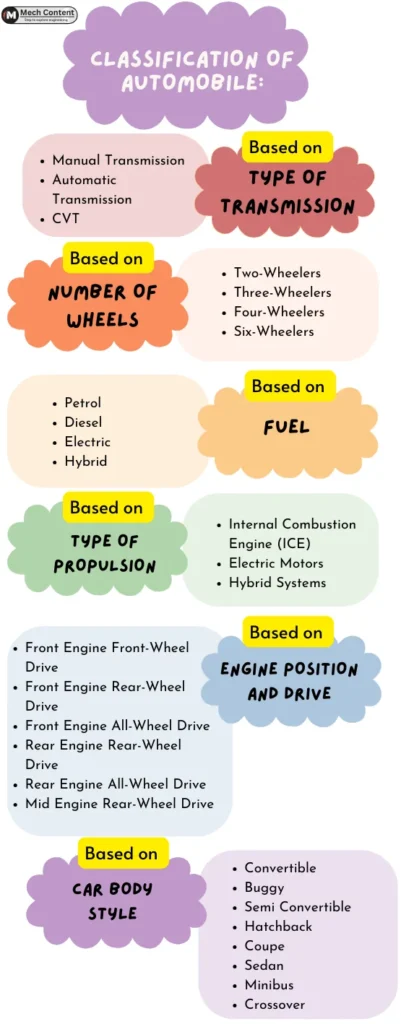
A] Based on Type of Transmission:
Automobiles can be classified based on their transmission systems:
- Manual Transmission: Requires the driver to manually shift gears using a clutch pedal.
- Automatic Transmission: Automatically changes gears without driver intervention.
- CVT (Continuously Variable Transmission): Provides seamless gear changes by using a system of pulleys.
B] Based on Number of Wheels:
The number of wheels can also classify automobiles:
- Two-Wheelers: Vehicles like motorcycles and scooters, primarily designed for two passengers.
- Three-Wheelers: Often used for short distances, such as auto rickshaws.
- Four-Wheelers: The most common type, including cars, trucks, and SUVs.
- Six-Wheelers: Typically larger vehicles, such as certain trucks or buses.
- Vehicles with more than six wheels: These include heavy-duty trucks or specialized vehicles for specific tasks.
C] Based on Fuel Used:
Automobiles are powered by different fuels, which leads to various types, each based on the fuel they use.
- Petrol: Commonly used in cars for its high energy content.
- Diesel: Preferred for its fuel efficiency, often found in larger vehicles.
- Electric: Powered by batteries, offering zero emissions during operation.
- Hybrid: Combines petrol and electric power for improved efficiency.
D] Based on Type of Propulsion:
Following is ths classification based on the different propulsion methods that powers the vehicle:
- Internal Combustion Engine (ICE): Uses fuel combustion to generate power. Based on the engines, automobiles can be majorly further categorized as: Spark Ignition (SI) engine and Compressed Ignition (CI) engine:
- Electric Motors: Use electricity from batteries for propulsion.
- Hybrid Systems: Combine ICE and electric motors for enhanced performance.
E] Based on Engine Position and Drive:
The position of the engine and type of drive lead to various configurations:
- Front Engine Front-Wheel Drive: The most common layout, enhancing space efficiency. Example: Honda Civic
- Front Engine Rear-Wheel Drive: Offers better handling, common in sports cars. Example: BMW 3 Series
- Front Engine All-Wheel Drive: Provides traction on various terrains. Example: Subaru Outback
- Rear Engine Rear-Wheel Drive: Found in vehicles like the Porsche 911.
- Rear Engine All-Wheel Drive: Combines rear engine with all-wheel drive for performance.
- Mid Engine Rear-Wheel Drive: Ideal for sports cars, providing balance and handling. Example: Ferrari 488
F] Based on Car Body Style:
Automobiles can also be categorized based on their body styles:
- Convertible: Features a retractable roof; example: Mazda MX-5.
- Buggy: Lightweight, often open, designed for off-road use.
- Semi Convertible: Partially enclosed, like a targa top.
- Hatchback: Compact with a rear door that swings upwards; example: Honda Civic.
- Coupe: Two-door with a sporty profile; example: Ford Mustang.
- Sedan: Four-door with a separate trunk; example: Toyota Camry.
- Minibus: Larger vehicle for passenger transport.
- Crossover: Combines features of cars and SUVs; example: Honda CR-V.
Key Parts and Systems in an Automobile:
An automobile is made up of various complex systems and components, each playing a crucial role in ensuring the vehicle runs smoothly. Here are some important systems that help you understand how an automobile works.
A] Engine and Transmission System:
This system includes the following components:
1] Engine: for Power Generation
The engine generates power through internal combustion, converting fuel and air into mechanical energy. As the first component to initiate power flow in an automobile, it is further connected to the transmission via the crankshaft.
Some of the key components of the engine include pistons, cylinders, connecting rods, crankshaft, valves, fuel injectors, etc.
2] Crankshaft: for Torque Transfer
The crankshaft transfers torque from the engine to the transmission. It’s a moving part, driven by the pistons’ motion. It is located within the engine block.
It consists of the following components: main journals, counterweights, flywheel mounting flange, crank pins, crank webs, oil passage, etc..
3] Transmission: for Speed and Torque Control
The transmission system regulates speed and torque by transmitting power from the engine to the wheels. Driven by the engine, it is located behind the engine and connects the engine with the driveshaft.
B] Fuel System
The fuel system consists of following vital components:
1] Fuel Tank: for Fuel Storage
The fuel tank holds fuel to keep the engine running. It is usually located at the rear of the vehicle. It further connects to the fuel lines and to the fuel pump. It’s made of metal or plastic and includes a fuel gauge and inlet/outlet valve.
2] Fuel Pump: for Fuel Delivery
The fuel pump is a device that delivers fuel from the tank to the engine, ensuring a steady flow for combustion. In diesel engines, the fuel pump operates at high pressure to improve fuel atomization. It is typically powered by the engine through the crankshaft. Fuel pumps are essential in internal combustion engines, particularly in modern gasoline and diesel vehicles.
3] Carburetor: For Air-Fuel Mixing:
Carburetors are used in older gasoline engines to mix air and fuel in the correct proportions for combustion. They regulate the fuel-air mixture based on engine speed and load. While carburetors were common in many vehicles, they have largely been replaced by fuel injectors in modern engines.
4] Fuel Injector: for Air-Fuel Mixing
The fuel injector sprays fuel into the engine’s combustion chamber (In CI engines). It is located into the combustion chamber of the engine, and fitted onto the intake manifold. It consists of nozzles and a control system that ensure precise fuel atomization for combustion.
C] Starting System
Following are some of the major components in this system:
1] Starter Motor: for Engine Ignition
The starter motor initiates the engine’s operation by rotating the crankshaft. It is located on the engine block, and gets power from the battery. It consists of an electric motor and a pinion gear that drives the engine’s flywheel.
2] Battery: for Power Supply
The battery supplies electrical power to start the engine and power electrical components. Positioned in the engine bay, it connects to the starter motor and ignition system. It is composed of cells and lead plates, it stores energy for initial ignition.
3] Ignition Coil and Spark Plug:
Ignition coils convert the low voltage from the battery into the high voltage required for ignition. This high voltage is delivered to the spark plugs, which generate a spark to ignite the air-fuel mixture in the engine’s combustion chamber.
D] Braking System:
Automobile braking system consists of some of the following important components:
1] Brake Pedal: for Driver Control
The brake pedal allows the driver to control braking. It is located in the footwell, and connected to the brake master cylinder. It consists of a pedal arm, return spring, and rubber pad for enhanced grip.
2] Brake Caliper: for Wheel Braking
The brake caliper applies pressure on the brake pads, slowing down the wheel. Positioned on each wheel, it connects to the brake lines. It consists of hydraulic pistons and a metal housing that ensure controlled braking.
In addition to these, the system also includes components such as the master cylinder, brake rotor, brake fluid, brake lines, brake booster, etc.
E] Exhaust System
Exhaust system in automobile consists of following components:
1] Exhaust Manifold: for Gas Collection
The exhaust manifold collects exhaust gases from the engine and channels exhaust gases efficiently. It is located on the engine cylinder head. Typically it is made of cast iron or steel.
2] Muffler: for Noise Reduction
The muffler reduces engine noise. It is located at the rear of the exhaust system, and further connects to the tailpipe. The muffler contains chambers and baffles that minimizes sound during exhaust flow.
F] Tires and Wheels System
1] Tires: for Road Contact
Tires provide traction and stability on the road by ensuring smooth movement and grip. They are mounted on wheels and connect directly to the wheel hubs. It typically consists of rubber, treads, and belts.
2] Wheel Hub: for Wheel Rotation
The wheel hub supports the wheels and allows rotation. It is connected to the axle and brake discs. It consists of metal and contains bearings for easy wheel movement.
G] Body and Chassis
1] Chassis: for Structural Support
The chassis is the structural frame that supports all vehicle components. All the major components like suspension, engine, and body panels are mounted on the chassis. It is typically made of materials like aluminium alloy, titanium alloy, stainless steel, etc.
2] Body Panels: for Aerodynamics and Protection
Body panels protect internal parts and shape the vehicle’s appearance. It is composed of steel, aluminum, or composites. It enhances aerodynamics and visual appeal.
How Automobiles Work: An Overview of Key Systems
Automobiles are complex machines made up of different systems that help them move, steer, and stop. Here is a simple explanation of how some of these key systems work.
How Automobile Move on the Road?
The motion of an automobile starts with the engine and extends through a series of interconnected components that ultimately make the wheels turn. Here is how power flows from the engine to the wheels:
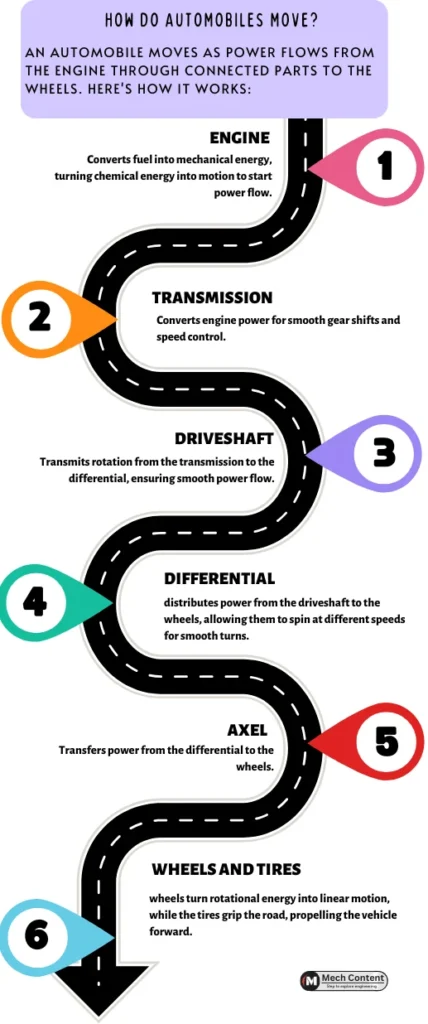
1] Engine (or Power Unit in EVs): The journey begins with the engine, which converts fuel into mechanical energy through internal combustion, transforming chemical energy into kinetic energy. This initiates the power flow in conventional vehicles.
Electric Vehicle Power Unit: For electric vehicles, the process starts with the Battery Pack, which stores electrical energy and supplies it as DC. A Power Inverter converts the DC into AC, powering the Electric Motor, which then generates mechanical energy to drive the wheels.
2] Transmission: The transmission regulates the engine’s power, adjusting it to suit the vehicle’s speed and load. By engaging the clutch, the engine’s power is smoothly transferred to the transmission, enabling precise gear shifts and efficient control of torque and speed.
3] Driveshaft: The driveshaft transmits rotational motion from the transmission to the differential, ensuring the uninterrupted flow of power to the next stage.
4] Differential: The differential receives power from the driveshaft and distributes it to the wheels. It adjusts the rotation of each wheel, allowing them to spin at different speeds, which is necessary while taking turns on road.
5] Axel: The axle connects the differential to the wheels, delivering the transmitted power directly to the wheels.
6] Wheels and Tires: Finally, the wheels convert the rotational energy into forward motion. The tires provide the necessary traction to grip the road. This interaction between tires and the road surface propels the vehicle forward, completing the process of motion.
How Automobile Steer on the Road?
Steering a vehicle involves a system of components working in sequence to change the direction of the front wheels. Here’s how this process happens:
1] Steering Wheel: The driver uses the steering wheel to initiate the turning motion. The rotational input from the driver starts the steering process.
2] Steering Column: The steering column connects the steering wheel to the steering gear. It transmits the driver’s input down to the steering mechanism.
3] Steering Gear: This mechanism converts the rotary motion of the steering wheel into a linear motion. It may be a rack-and-pinion system or a recirculating ball system, which moves the tie rods accordingly.
4] Tie Rods: Tie rods are connected to the steering gear and extend to the steering knuckles. They push and pull to turn the wheels left or right as needed.
5] Steering Knuckles: The knuckles are mounted on the axle and allow the wheels to pivot and steer the vehicle. They play a vital role in directing the wheels based on input from the tie rods.
How Automobile Braking System Work?
Braking is essential for vehicle control and safety. Different braking systems work in various ways to stop an automobile, each relying on distinct mechanisms. Below is a breakdown of the components involved in stopping an automobile:
1] Brake Pedal: The process starts when the driver presses the brake pedal, initiating the braking action in any system. In mechanical braking, this may activate a direct linkage, while in hydraulic or pneumatic systems, it activates the respective fluid or air pressure transfer.
2] Braking System: Depending on the vehicle, various braking systems are involved:
- Mechanical Braking System: Uses mechanical linkages that connect the brake pedal to the braking mechanisms at each wheel, causing the brakes to engage directly.
- Hydraulic Braking System: Involves hydraulic fluid that transfers pressure from the brake pedal through the master cylinder to brake components at each wheel.
- Pneumatic Braking System: Uses compressed air to transmit pressure from the brake pedal to the braking mechanisms, typically found in large vehicles like trucks or buses.
3] Braking Mechanisms (Calipers, Drums, or Shoes):
- Disc Brakes: When the braking system is hydraulic or pneumatic, the pressure causes the brake calipers to clamp down on the brake rotors, creating friction and slowing down the wheel’s rotation.
- Drum Brakes: In vehicles with mechanical or hydraulic systems, brake shoes press outward against a rotating drum, creating friction that reduces the wheel’s speed.
4] Brake Pads and Rotors: For disc brakes, brake pads interact directly with the rotor to convert kinetic energy into heat, reducing speed efficiently.
5] Tires: The friction between the tires and the road completes the braking process, bringing the vehicle to a halt.
Each of these systems plays a critical role in ensuring that the vehicle functions efficiently, providing control, maneuverability, and safety on the road.
Wrapping Up:
Automobiles have come a long way, from early inventions to today’s advanced models. Explore our articles in the Automobile category to learn more about automobiles, different components, and how they work. There’s so much to discover!